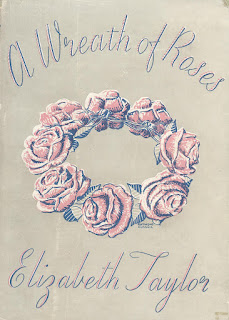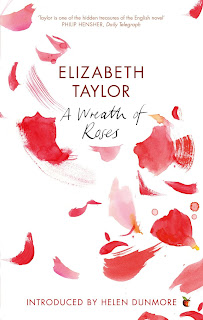A Wreath of Roses by Elizabeth Taylor
While canonical literary history has generally told the story of 20th Century British fiction as the story of men, with some exemplary women here and there, we have enough distance now to see that while the men were certainly the grabbers of headlines and awards, their canonicity was less a matter of merit than of their control of the culture industry. The men ate up all the air in the rooms of litchat. Meanwhile, by and large it was women who wrote the fiction that has survived the years the best, and which remains most readable and interesting today. This is especially true around midcentury, where we can speak of Rebecca West (1892-1983), Sylvia Townsend Warner (1893-1978), Naomi Mitchison (1897-1999), Elizabeth Bowen (1899-1973), Anna Kavan (1901-1968), Stevie Smith (1902-1971 [best known as a poet, but author of 3 interesting novels]), Leonora Carrington (1917-2011), Muriel Spark (1918-2006), Iris Murdoch (1919-1999), Doris Lessing (1919-2013) — and many others, both well-known and neglected.
One of the writers I've left out of that list is one I've become increasingly interested in: Elizabeth Taylor (1912-1975), a novelist and short-story writer who had the bad luck to begin publishing just as another woman named Elizabeth Taylor (1932-2011) became an international star. I first discovered Taylor through her stories — "The Devastating Boys" is included in the excellent anthology Empire Windrush (aka Hurricane Hits England) edited by Onyekachi Wambu, and I read it five or six years ago in amazement: who was this writer? why had I never heard of her? The story was very much of its era, but also quietly, richly more than a slice-of-postwar-life. Right around that time, NYRB Classics released You'll Enjoy It When You Get There: The Stories of Elizabeth Taylor edited by Margaret Drabble; I picked up a copy, read a couple stories (with further amazement), but then had to give my attention to other writers and other work, and Taylor fell by the wayside. Indeed, I forgot all about her.
Sorting through piles of books for reshelving a few months ago, I came across my copy of You'll Enjoy It When You Get There, and remembered "The Devastating Boys", which I had filed in my memory as by Elizabeth Bowen. Having spent lots of time recently with Sylvia Townsend Warner's stories, I was intrigued by Taylor's stories again, since Taylor, too, published frequently in The New Yorker, where her editor was also Warner's: William Maxwell.
(A momentary tangent: Though there have been various anthologies of New Yorker writings published through the years, there has not, to my knowledge, been a collection of the magazine's short stories by women. There ought to be, because it would help us see a line of excellent work that has been obscured by the overstuffed reputations of people like John Updike.)
In addition to her stories, Elizabeth Taylor also published twelve novels (including one posthumously), most (all?) of which are still in print either through NYRB Classics or Virago. I don't remember why I chose A Wreath of Roses to start with rather than one of her other novels, but it may simply have been that the ebook was inexpensive and so seemed like a good bet.
It was a good bet, indeed. A Wreath of Roses succeeds in being a book in which nothing and everything happens. There is no plot, simply encounters and scenes, and yet there is tension and even a sense of menace. Jane Housham is right in locating the tension/menace in the fact that the novel was written shortly after World War II: "The psychological damage wrought by the recent war subtly and convincingly underpins this account of three variously unhappy women and three ill-assorted men who may or may not offer them the hope of happiness." The memory of war haunts the whole novel, with each of the characters in their own way trying to find meaning in life and action, in work and play, in other people. Violence looms, but the only on-stage (as it were) violence in the book happens at beginning and end, with suicides that echo each other. (Suicides, notably, of men: What does a world after war offer to the alienated male?)
Taylor deeply admired Virginia Woolf and E.M. Forster — she even wrote Woolf a fan letter about The Waves, reprinted in Nicola Beauman's biography The Other Elizabeth Taylor; Woolf replied, but the reply was lost in a flood in the early 1940s. While in A Wreath of Roses the influence of Forster is clear in structure and tone, we glimpse Woolf in the constant attention to consciousness, and how thoughts and ideas often conflict with what people say. And Woolf's words are in fact present on Taylor's pages, with the book beginning with an epigraph from The Waves: "So terrible was life that I held up shade after shade. Look at life through this, look at life through that; let there be rose leaves, let there be vine leaves – I covered the whole street, Oxford Street, Piccadilly Circus, with the blaze and ripple of my mind, with vine leaves and rose leaves."
This epigraph is telling, because it points us toward one of the central questions of the book: Why live? The question is answered differently by the characters, with varying levels of conviction (both for themselve and for us, the readers). Love, religion, art, marriage, children — all are shown to be both sufficient and inadequate to life. Frances, for instance, whose house serves as a hub for the story, is an elderly painter who devoted most of her life to raising other people's children. Her painting has recently taken a darker turn, one that reflects a nihilistic worldview she is only now admitting. Thinking of her earlier paintings, she wonders if she was not "guilty of making ugliness charming? An English sadness like a veil over all I painted, until it became ladylike and nostalgic, governessy, utterly lacking in ferocity, brutality, violence. Whereas in the centre of the earth, in the heart of life, in the core of even everyday things is there not violence, with flames wheeling, turmoil, pain, chaos?"
This lack of "ferocity, brutality, violence" seems to be just what appeals to a man obsesssed with her paintings, Morland Beddoes, a bachelor who is also a good listener and thus a magnet for other people's emotions and gossip, and who spent years as a prisoner of war in Germany:
Though loving people, he loved stillness more, and visual beauty. He desired the woman who would never raise her voice, nor snivel into a handkerchief, nor encroach on another’s private territory. He did not marry. He collected pictures. He collected especially the pictures which would help him to forget the cracked façades, the tear-stained faces which dogged him always.Frances' new work is unlikely to appeal to Morland and the many other people who have provided Frances with a new career late in life and a certain fame. But they are, to her, her most honest paintings. "You will hate these paintings," she tells Morland. "But you must remember that people change – even at my time of life a woman can change. I committed a grave sin against the suffering of the world by ignoring it, by tempting others with charm and nostalgia until they ignored it too."
Now contemplating her life and fate, Frances can't help but see human existence as a tiny drop of paint on the infinite canvas of the universe. Against the fact of entropy, what use is art? "The only thing that makes sense of it all," she thinks, "is looking up at the sky at night and knowing that even the burden of cruelty we’ve laid upon the earth, scarcely exists: must fly away into dust, is nothing, too infinitesimal to matter. All the time, the house is falling into ruin, and I run to the walls and tack my pretty pictures to them as they collapse."
The truth and meaning she finds in art is that it captures a moment in the endless flow: "Life itself is an unfinished sentence, or a few haphazard brush-strokes. Nothing stays. Nothing is completed. I can make nothing whole from it, however small. Pinned down, like a butterfly, it ceases to be itself, just as the butterfly becomes something else; dead, unmoving, its brightness gone. The meaning of a painting is a voice crying out: 'I saw it. Before it vanished, it was thus.' An honest painting would never be finished; an honest novel would stop in the middle of a sentence. There is no shutting life up in a cage, turning the key with a full-stop, with a stroke of paint."
The other characters try to make sense of life in their own ways, and none is quite so given to philosophizing as Frances. Late in the novel, Liz and Morland discuss Frances:
‘I wonder if Frances dreams of … I can’t really imagine what …’ [Liz said.]There's a Chekhovian quality to this exchange — a serious discussion of suffering and art where characters talk across each other and yet together admit the unknowableness of life, the absurdity, via laughter that even they don't quite understand. It feels somehow more honest (or at least more true, or more useful) than the unrelieved darkness that suffering often inspires. Because suffering is constant and universal and everywhere; if anything is universal in life, it is suffering, and a clear-eyed view of things ought to lead us more toward Frances' point of view, or even that of Ligotti's Conspiracy Against the Human Race, but that's also the path toward suicide. If we are going to reckon, somehow, with the infinite and universal fact of suffering, then we must head more toward the Buddhists and the absurdists, we must go on, laughing in between tears, even if we don't know why. Morland Beddoes is right: Artists are types of people who have found a way to put suffering to good account. Thus we must find the art of living, as Frances, even at her darkest, has done. Otherwise, we end up like the suicides in the novel, those bookends to this book, its warning signs.
‘Her work is her dream. Anything else would be a distraction.’ [Morland replied.]
Both talked of one thing, were thinking of another.
‘No glamour, enchantment?’
‘The reality must be such an enchantment, that applause afterwards would be only an echo of it. Artists do indeed inherit the earth.’
‘They suffer though,’ Liz said. ('In such a nice way,’ she thought. It was a suffering she could easily bear for them to have.)
‘We all suffer. They put it to good account.’
‘I call it passing the buck,’ she murmured; then made haste to agree with him. ‘Oh, yes,’ she said vaguely, ‘they work away like beavers and turn the grit into a pearl. And what is so funny about that?’ she asked, joining in his laughter.
As a coda, I must note that I write this during the time of the COVID-19 pandemic, a time when cities are shut down, the economy has ground to a stop, and suffering, sickness, and death are everywhere not only in actuality but also in anticipation. We expect, of the next few weeks, for everything to get worse around us here in the U.S., as we are a couple weeks behind Italy in the trajectory of infection, and right now Italy has no more room in its morgues. I'm sure that affected my interpretation of the novel, but it also affected my appreciation of it, an appreciation that was perhaps deeper than it would have been otherwise, because this, too, is a novel about anticipation, about life in between cataclysms (personal and social), life in the midst of struggle and suffering. Seventy-one years old, A Wreath of Roses has much to say to our now.

